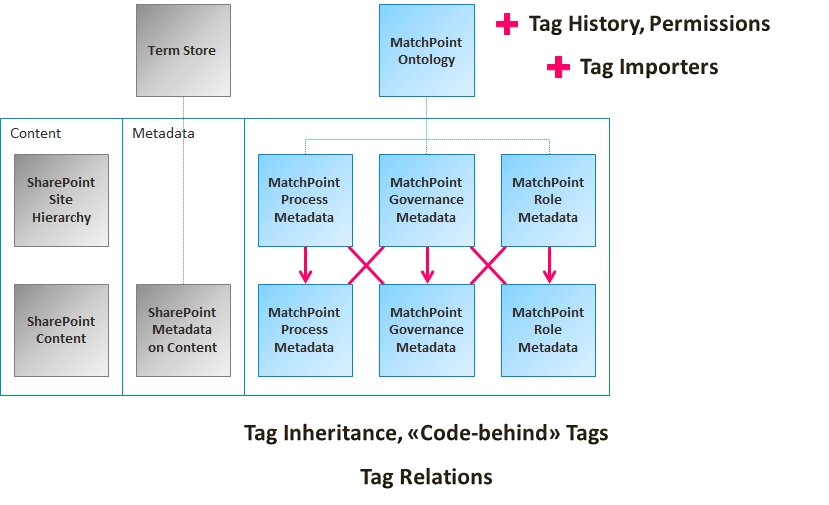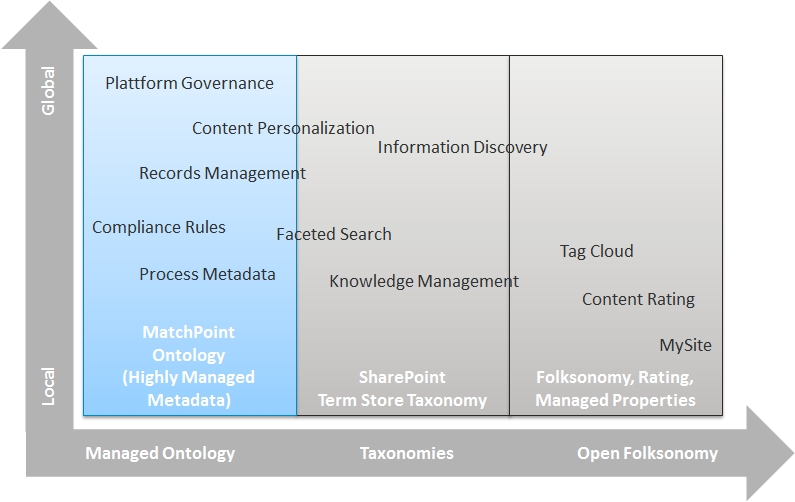How to Improve SharePoint Metadata Management with MatchPoint
Date: 07.09.2011
Metadata is like glue, holding SharePoint content together. Metadata is not only improving search but is an indispensable foundation for social media and many important content management concepts such as personalization and relevancy. Few things will have a bigger impact on the success of your SharePoint applications than metadata quality.
SharePoint 2010 offers a couple of things to manage metadata. But the out-of-the-box features won?t do if you?re into designing semantic or search-based applications or if information governance is crucial. Especially the technical implementation of your governance plan and compliance rules can be very complex and often requires a lot of custom development.
Let me just mention three key requirements that are hard to be met and show you how MatchPoint is helping you to achieve your goals:
Taxonomy quality: the consistency of your metadata model is fundamental. But to maintain a taxonomy is time consuming and error-prone
-> MatchPoint provides a connector framework to attach your business applications to the SharePoint taxonomy. Instead of manually manage your metadata model, use your ERP or CRM or any other business system to repeatedly update the SharePoint taxonomy directly from your leading sources. MatchPoint even keeps track of historical metadata and metadata relations and propagates updates to existing content immediately and without the necessity of full index updates, thus being easy on your system resources (Figure 1)

Tagging quality: given that you provide a clean taxonomy, you have to make sure that content is classified consistently and comprehensively. But authors and users tend to save content without or with inconsistent metadata
-> MatchPoint provides content-independent automatic tagging features so you can relieve your users from the burden of manual classification (Figure 2). Taxonomy managers can tag SharePoint site and folder structures and configure rules to automatically inherit metadata to content. MatchPoint can also be configured to automatically tag content using rules or workflows and using relations in our ontology

Metadata use: once you have good metadata quality, you want to make use of them in your applications. But SharePoint offers only few out-of-the-box Web Parts capable of dealing with metadata
-> Metadata filters can be plugged into all MatchPoint Web Parts to configure conditions and for content personalization. And metadata can be used in expressions to control connected Web Parts based on our AJAX Connection Framework
-> MatchPoint is capable of automatically create metadata for SharePoint sites, MatchPoint roles, workflow actions or governance information, thus making important business concepts available through the SharePoint index. In combination with ?traditional? metadata, site, role, process or governance metadata form a powerful filter set with unlimited combination and analysis possibilities.
To summarize, MatchPoint?s award-winning metadata management features seamlessly integrate into all of its components. MatchPoint dynamically creates relations between content, users, processes and applications and stores them in the SharePoint index. Almost every aspect, whether it is a descriptive attribute, status information out of a process, a user role or a governance property, can be transformed into valuable metadata on the fly. MatchPoint features even stretch into your line of business applications, allowing you to keep the sources of your business data in sync with SharePoint content. This makes it very easy to display information in various contexts, using standard search queries in combination with metadata filtering, and to provide a global, cross-application context. The most important MatchPoint components related to metadata are:
- The MatchPoint Tagging Features for automatic tagging
- The MatchPoint Ontology and its Connection Framework for minimizing metadata management effort and maximizing consistency
- The metadata-enabled MatchPoint Web Parts with integrated filtering and personalization capabilities
- The MatchPoint Data Provider Framework for supporting data aggregation from various sources
- The MatchPoint Configuration Framework and Expression Engine for no code solutions